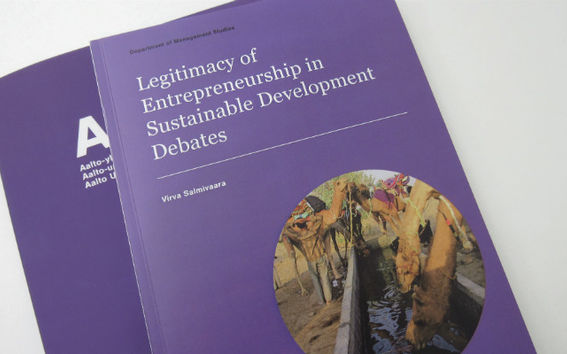Who decides whether entrepreneurship is the way to sustainable development?

In political debate, entrepreneurship is being emphasised more and more as a solution to improve social justice and environmental problems. Understanding the societal legitimacy of entrepreneurship will help in critically assessing this debate. Furthermore, it sheds light on how the hidden potential of entrepreneurship could be accepted as part of broader sustainable development, claims Virva Salmivaara in her doctoral dissertation to be defended on 13 December at the Aalto University School of Business.
‘When thinking about sustainable development solutions, it is important to be aware of what makes us prefer certain approaches and operating models’, Salmivaara points out when explaining the starting point of the research.
‘In research into entrepreneurship it is often seen as almost self-evident that entrepreneurship has an important role as an enabler of sustainable development and then moves on to examine how companies that generate social and environmental benefits operate. There has been little research into the wider acceptability and willingness to see entrepreneurship as a solution to sustainable development’, says Salmivaara.
Strong connection with national policy
In her dissertation, Salmivaara has examined the ideological, political and social factors that influence the legitimacy of entrepreneurship at the supranational, national and community level.
The quantitative research that covered 11 welfare states showed that local experts emphasised the importance of entrepreneurship when national policy was consistent with regard to markets and social welfare.
‘Entrepreneurship is seen as a means of solving social problems in countries where the state gets involved either very little or to a great extent in the functioning of the market and organising social welfare. If there are inconsistencies between these areas entrepreneurship is not considered to be so useful’, says Salmivaara.
Sustainable development entrepreneurship stems from communities
‘In both developing and developed countries certain municipalities and communities have suffered badly when, for example, production has been moved elsewhere. There are many examples in the world of communities that have not resorted to development projects coming from the outside, but instead have launched joint business activities in order to improve local conditions and to maintain commercial vitality’, says Salmivaara.
Examples of this kind of entrepreneurship are the jasmine pickers’ community in India’s Karnataka or a new enterprise that arose after the collapse of a local pub in Hudswell in England.
‘In these situations, entrepreneurship is more a social than market-driven process. Launching an entrepreneurial activity intended for the common good requires new kinds of co-operation as well as changes to the way the community sees itself and the resources it has available’, Salmivaara observes.
Further information:
Virva Salmivaara
[email protected]
tel. +358 (0)50 441 8111
- Published:
- Updated:
Read more news

Get to know us: Associate Professor Maria Sammalkorpi
Sammalkorpi received her doctorate from Helsinki University of Technology 2004. After her defence, she has worked as a researcher at the Universities of Princeton, Yale and Aalto.
Aalto computer scientists in ICML 2024
Computer scientists in ICML 2024
Getting bacteria into line
Physicists use magnetic fields to manipulate bacterial behaviour